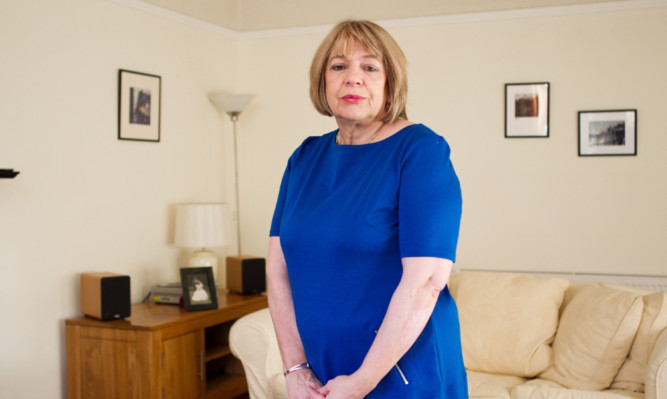
The wife of a vulnerable dementia sufferer has hit out amid allegations her husband was left covered in bruises after being restrained by police.
Frances Hunter claims Alistair, 58, who has early onset Alzheimer’s, was treated “like a common criminal” after becoming agitated in his care home.
She is outraged she was not informed that staff had called police to restrain her husband, despite the fact she has power of attorney over his affairs.
It’s alleged his treatment which saw the former IT consultant shackled with restraints called fast-straps left him covered in bruises.Support our Care Home campaignLast night, experts slammed the practice of sending police into care homes to deal with dementia sufferers. Meanwhile, a mental health watchdog has called for an investigation into the incident, which happened at Silverburn Care Home in Pollock, Glasgow.
Frances, 59, said: “He was treated like a common criminal. “We’ve only ever had two parking tickets between us and yet in a vulnerable state he was restrained by police. It must have been so frightening for him.”
Fast-straps are normally used by police to restrain violent, struggling prisoners. They are an unbreakable fastening strap which can be wrapped around peoples’ wrists and legs.
Their use in this case has disturbed Scottish Conservative health spokesman Jackson Carlaw who said there must be a better way of dealing with the situation.
He said: “If a facility is tasked with looking after dementia patients, the expectation would be that it should have the necessary expertise on-site. Involving police will have been extremely upsetting for the patient and his family. Perhaps as rates of this condition increase, police will have to look at how officers are prepared to take on such challenging situations.”
On March 15, just weeks after being placed in the home, staff phoned Frances to say police had been called to deal with Alistair’s threatening behaviour.
“They said he wouldn’t be charged this time,” she said. “I couldn’t believe what I was hearing. How could they consider charging a man who didn’t know what he was doing? But I thought it was a one-off and things calmed down again.”
A week later Frances received a call to say Alistair had been heavily sedated after an “incident”. She was then informed by a doctor her husband had been taken away from the home and sectioned under the Mental Health Act.
She said: “It was like a bolt from the blue. As far as I was aware there was nothing wrong with him and he was getting on as well as someone with his condition could.
“What compounded the issue was I hadn’t been told anything that had been going on behind the scenes despite being his power of attorney.
“When I later went to get his clothes, staff told me there had been a real struggle.”
Alistair was taken to an NHS secure facility, where he is still being cared for.
Frances added: “It’s been horrific. There are huge problems with dementia care in this country, especially the lack of facilities for someone like Alistair. You wouldn’t put a child in an adult hospital ward, so why would the only option of care for a 58-year-old be in with 80 and 90-year-olds?
“The police aren’t dementia specialists so why are they being used to deal with people who have a medical condition? You put someone in a home believing they are able to cope.”
Alistair, of Giffnock, East Renfrewshire, was first given the shock diagnosis in 2011 after he had started forgetting numbers, how to work technology and disappearing for hours at a time. Family feared the normally fit married man had been struck by a deadly brain tumour or suffered a nervous breakdown. Instead, doctors delivered the blow he had early onset Alzheimer’s after tests confirmed the disease.
Frances said: “He is a fantastic husband and my best friend so to be told that I was slowly and irreversibly losing him was hugely upsetting. We decided to get things in order so I became his power of attorney.”
For three years, Frances looked after her husband while holding down a full-time job with the local authority. But at the start of 2014 they made the heart-breaking decision to put him into care after his condition deteriorated and he began suffering hallucinations.
“We tried a few care homes before deciding on putting him in full-time into Silverburn Care Home in March,” said Frances, who secured funding believed to be around £770-a-week through East Renfrewshire Council.
Silverburn claims to be a dementia specialist providing “person-centred methods within a warm, healthy environment”.
The Care Inspectorate carried out an inspection of the home in July and said it had concerns over its management and staffing levels, giving it a “weak” rating.
A spokesman for the home said: “Under the Adult Support and Protection Act we are required by law to call the police if we feel staff or patients are being threatened. It is not all the time but when it is deemed necessary.
“When we do so, we have specific procedures to follow. I am unable to speak about any specific cases because of confidentiality issues.”
Police Scotland confirmed they had attended an incident at the home to “offer advice and assistance”. They said no-one was arrested and confirmed fast-straps were used to restrain the patient “but were taken off him when the situation calmed down”.
Dr Jean Turner, of Scotland Patients Association, said: “What we want in our care homes is enough qualified staff to be able to deal with situations like this.”
Online Form – Who Cares Sunday Post CampaignOnline Form Generator

Enjoy the convenience of having The Sunday Post delivered as a digital ePaper straight to your smartphone, tablet or computer.
Subscribe for only £5.49 a month and enjoy all the benefits of the printed paper as a digital replica.
Subscribe